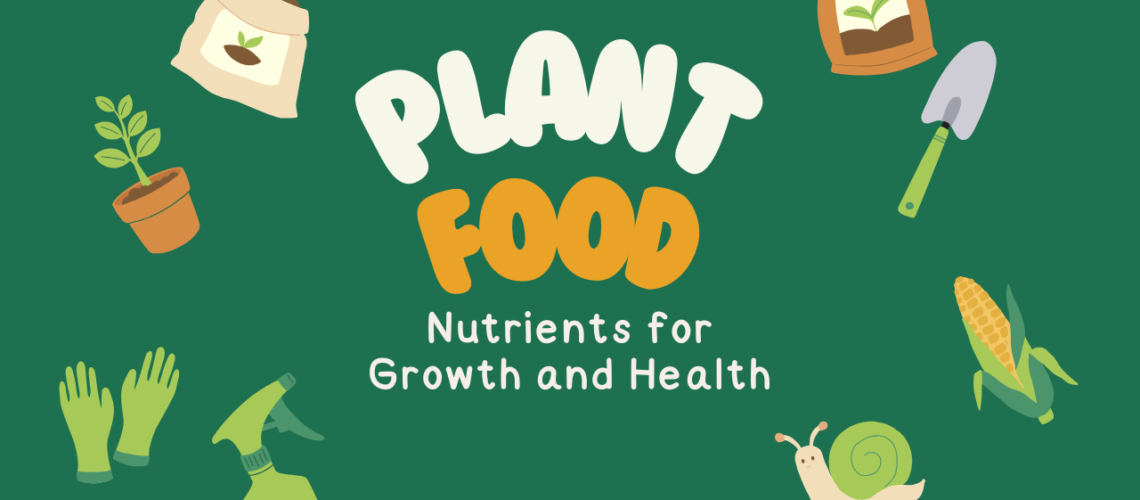Understanding Plant Food: Nutrients for Growth and Health
September 3, 2024

Plant food, often known as fertilizers or soil amendments, is essential to the development and well-being of plants. Knowing the many kinds of plant food, their ingredients, and their uses will greatly improve your gardening success, regardless of your level of gardening experience. This article explores the value of plant food, its various varieties, and how to select the best kind for your plants.
The Importance of Plant Food
Like all living things, plants need nourishment to survive. They nevertheless require a range of minerals and nutrients from the soil to maintain their growth, reproduction, and disease resistance even though they are able to make their own food through photosynthesis. These vital nutrients are supplied by plant food, which enables plants to flourish, bear fruit and blooms, and stay healthy overall.
Essential Nutrients
The two types of nutrients found in plants are called macronutrients and micronutrients.
1. Macronutrients: The main type of nutrients that plants require in significant amounts are these. They consist of:
- Nitrogen (N): An essential component of chlorophyll, the substance used by plants for photosynthesis, nitrogen is also necessary for the growth of leaves and stems.
- Phosphorous (P): Phosphorus aids in the passage of energy within plants and is crucial for root development, blooming, and fruiting.
- K+ Potassium: Potassium plays an important role in disease resistance, protein and carbohydrate synthesis, water management, and general plant health.
2. Micronutrients: Although required in lesser quantities, they are just as vital to the health of plants. Among them are:
- Iron (Fe): Essential for enzyme activity and the synthesis of chlorophyll.
- Manganese (Mn): Contributes to nitrogen metabolism and photosynthesis.
- Zinc (Zn): Essential for controlling growth and producing hormones.
Types of Plant Food
There are many different types of plant food, and each has advantages and uses of its own. Some of the most typical kinds are listed below:
1. Organic Fertilizers
The natural sources of organic fertilizers include plant and animal debris. Since they release nutrients more gradually, there is usually a consistent supply throughout time. Typical organic fertilizers include of:
- Compost: Organic matter that has broken down and added nutrients to the soil while also strengthening its structure.
- Manure: Animal excrement that is a rich source of nutrients, including nitrogen.
- Bone Meal: A phosphorus-rich food produced from ground animal bones that encourages robust root development.
2. Synthetic Fertilizers
These are produced chemically and frequently offer nutrients in a concentrated form. Generally speaking, they work more quickly than organic fertilizers. Among the synthetic fertilizers are:
- Granular: Small pellets suitable for soil application.
- Liquid: Nutrient solutions that are suitable for foliar spraying or for direct application to the soil.
3. Slow-Release Fertilizers
By releasing nutrients gradually over time, these fertilizers lower the chance of nutrient leaching and offer a consistent supply. They are perfect for long-term plant health and can be synthetic or organic.
4. Liquid Fertilizers
For rapid nutritional enhancements, liquid fertilizers are frequently employed. To enable quick absorption by the plants, they can be sprayed directly onto the soil or given as a foliar spray. These are very helpful when the plants are expanding and need more nutrients.
Choosing the Right Plant Food
The type of plants, the state of the soil, and the particular nutrient requirements are some of the aspects that must be taken into consideration when choosing the right plant food. These pointers will help you select the appropriate fertilizer:
1. Soil Testing
Conducting a soil test is advisable prior to applying any fertilizer. This will assist in figuring out your soil’s nutritional levels and identifying any inadequacies. Soil testing kits are available from many garden centers, or you can mail a sample for analysis to your local agricultural extension agency.
2. Understanding Plant Needs
The nutrients that different plants require are different. For example, while blooming plants benefit from higher levels of phosphorus, leafy greens like lettuce sometimes require more of the mineral. To choose the best fertilizer, find out what your plants specifically require.
3. Follow Instructions
Always adhere to the application rates and procedures recommended by the manufacturer. Nutrient burn caused by overfertilization can damage plants and can have negative environmental effects via runoff.
4. Timing is Key
The right timing of fertilization is essential for healthy plant growth. Plants can absorb nutrients more efficiently if fertilizers are applied during the active growing season. This usually occurs in the spring and early summer for most plants.
Environmental Considerations
Although fertilizers are necessary for plant growth, using them may have negative impact on the environment. Overapplication may result in discharge of nutrients that contaminate water sources and cause algal blooms. Take into account the following procedures to lessen these problems:
- Employ Native Plants: Native plants are more suited to the local soil conditions and frequently require fewer nutrients.
- Compost: Adding compost to your garden can improve soil health without having the harmful effects of modern fertilizers.
- Use Integrated Pest Management: You can keep your garden’s ecosystem in balance by using less chemical pesticides.
Conclusion
Plant food is essential to successful gardening because it supplies the nutrients required for strong plant growth. You may establish a successful garden by learning about the various types of fertilizers, how to use them, and the particular requirements of your plants. To make sure that your gardening endeavors have a positive ecological impact, never forget to take into account the effects on the environment and aim for sustainable practices. Your plants will flourish and provide years of beauty, food, and delight if you have the appropriate knowledge and approach.